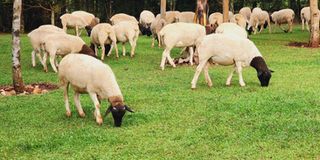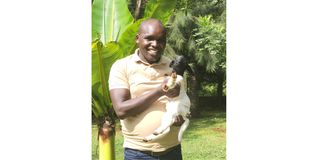Premium
Boredom at peak of Covid pushed him to lucrative climate smart dorper farming

Isaac Kosgey, a farmer from Nandi County, rears dorper sheep and galla goats, breeds that are famed for their ability to adapt to harsh and changing climatic conditions.
Modern industrial agriculture, that has seen farmers use synthetic fertilisers and chemical pesticides started more than 200 years ago, then praised as the easiest and most effective way of increasing yields that would feed a growing human population.
Industrial agriculture is defined by the Natural Resources Defense Council as “large-scale, intensive production of crops and animals.
This "often involves chemical fertilisers on crops or the routine, harmful use of antibiotics in animals. It may also involve crops that are genetically modified, heavy use of pesticides and other practices that deplete the land, mistreat animals and increase various forms of pollution.”
The dangers of such practices on the environment have in the recent decades seen a rise in campaign for sustainable agricultural practices that not only feeds the population but also reduces negative impacts on the environment.

Isaac Kosgey at his farm with one of his sheep.
While chasing his passion, Isaac Kosgey, a farmer from Nandi County, has managed to merge his passion for farming and the need for sustainable agriculture, in his project that has seen him rear dorper sheep and galla goats, breeds that are famed for their ability to adapt to harsh and changing climatic conditions.
At the height of the Covid-19 pandemic in 2020, he was bored, with a lot of time on his hands, and no activities to fill them in.
It was time to execute his dream, and, using his skills that he had gained from working in an agribusiness industry, combined with years of research and knowledge gathered from farmers, to push it to success.
“When the pandemic hit, it found me already deep into my research. I had found out that most people from the Middle East were coming to Kenya to purchase dorper sheep and galla goats for meat, and that few farmers were doing this type of farming. The idea of Dorper sheep farming was also a dream that I couldn’t execute earlier because of time constrictions.
In April 2020, with Sh100,000, I bought five dorper ewes from a local breeder, and one quality ram from a renowned breeder,” recalls Kosgey.
He explains that he chose the two breeds because they produce high quality milk, meat and wool, taking half the time that other local breeds take to mature and gain weight. The sheep also fetch high prices in the market, with rams aged six months going for Sh20, 000 each, ewes for between Sh15,000 and Sh25,000. Those over a year old are sold at Sh40,000.
His other reason for choosing the breed, he discloses, lay in the fact that they are environmentally friendly and are easy to manage.
“Cattle are one of the biggest contributors to global warming because of methane that they release and the production practices surrounding them. Small ruminants like dorper sheep help cut down these emissions. You also do not need a large chunk of land, you can practice zero grazing, as long as you get enough feed and do regular deworming and vaccination,” he explains.
Even though his flock caught up quickly, with all five ewes birthing lambs by July of the same year, Kosgey was yet to be hit by diseases that would kill some of his sheep.
“I was still learning how to manage this breed. The biggest challenge turned out to be the barbers pole worm, and diseases including pulpy kidney, enterotoxaemia and lamb dysentery. It took a toll on us and we lost four sheep,” recalls Kosgey.
“We also experienced challenges in securing capital meant feed production. I quickly realized that to cut costs in production, I needed to produce my own feed. However, getting a piece of land to grow the feed was tough, and expensive,” he adds.
A year down the line, in 2021, after purchasing a high qualityhigh-quality ram from Dorper Sheep Breeders’ Society of South Africa, Kosgey decided to become a messenger of dorper sheep farming to his community.
“We were linked to an expert from the society who made sure that the ram thrived and adapted well to its new home. She taught us new tricks, best feeds, and how to conduct breeding. She shared a lot of information, and we decided to be generous and educate others. We registered our farm, then set up a Facebook page, and started posting and conducting trainings,” says Kosgey.
Post Covid-19, Kosgey still works at an agribusiness company, with his parents supervising his farm, which has become a model farm and a Centre of excellence in dorper breeding in the North Rift region.
“Dorper sheep farming is getting bigger because of quality meat, with buyers from the Middle East requiring about 10,000 sheep a day for mutton. Farmers need to invest in quality genetics, by stopping practices such as inbreeding. If we take this seriously as a profession and focus on breeding animals that grow so fast, we will not only protect our environment, but we will earn a lot of income,” he advises.
“Our main achievements include a July 2021 sale of 60 sheep to farms across North Rift. In July 2022, we supplied Elgeiyo Marakwet with 200 under World Bank’s emergency locust program. Between August 2021 and now, we have been supplying West Pokot and EMC under World Bank’s climate smart project where we have supplied a total of 2,200 animals to date,” explains Kosgey.
According to Dr Kinyanjui Koimbori, a senior researcher from Chinese Academy of Agricultural Sciences, dorper sheep farming may profit the environment because of lesser methane emissions, as compared to those emitted by ruminants that are larger in size.
“Because the dorper sheep are also smaller in size, they consume less in terms of vegetation, and contribute less to land degradation. They also do well in harsh climatic conditions, and are able to handle the African terrain. They are also better at fighting off many diseases,” says Dr Koimbori.
“Besides, they produce high quality milk wool and meat. They are therefore a good bread that adapts well to Kenya’s rapidly changing climatic conditions,” he adds.
Dorper sheep were introduced to the country by Kenya Agricultural Livestock and Research Organisation(KALRO) about 10 years ago, but gained fame recently with the ever changing weather conditions occasioned by climate change.
This publication was produced with the financial support of the European Union. Its contents do not necessarily reflect the views of the EU.





